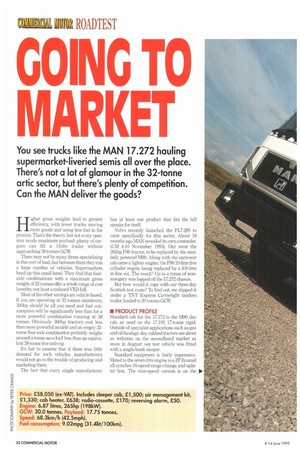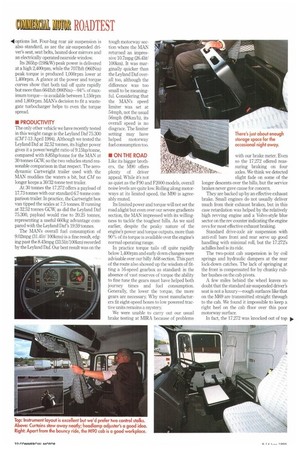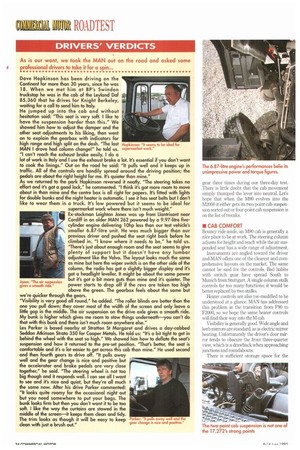GOING TO MARKET
Page 32

Page 34

Page 36

Page 37

If you've noticed an error in this article please click here to report it so we can fix it.
You see trucks like the MAN 17.272 hauling supermarket-liveried semis all over the place. There's not a lot of glamour in the 32-tonne artic sector, but there's plenty of competition. Can the MAN deliver the goods?
Higher gross weights lead to greater efficiency, with fewer trucks moving more goods and using less fuel in the process. That's the theory, but not every operator needs maximum payload: plenty of cargoes can fill a 13.6m trailer without approaching 38 tonnes GCW.
There may not be many firms specialising in this sort of load, but between them they run a large number of vehicles. Supermarkets head up this small band. They find that fouraxle combinations with a maximum gross weight of 32 tonnes offer a whole range of cost benefits; not least a reduced VED bill.
Most of the other savings are vehicle based. If you are operating at 32 tonnes maximum, 300hp should be all you need and fuel consumption will be significantly less than for a more powerful combination running at 38 tonnes. Obviously 300hp tractors cost less than more powerful models and an empty 32tonne four-axle combination probably weighs around a tonne-an-a-half less than an equivalent 38-tonne five axle rig.
It's fair to assume that if there was little demand for such vehicles, manufacturers would not go to the trouble of producing and marketing them.
The fact that every single manufacturer has at least one product that fits the bill speaks for itself.
Volvo recently launched the FL7.285 to cater specifically for this sector. About 18 months ago MAN revealed its own contender. (CM 4-10 November 1993). Out went the 265hp F90 tractor, to be replaced by the similarly powered M90. Along with the narrower cab came a lighter engine; the F90 10-litre five cylinder engine being replaced by a 6.9-litre in-line six. The result? Up to a tonne of ironmongery was lopped off the 17.272 chassis.
But how would it cope with our three-day Scottish test route? To find out, we slipped it under a TNT Express Cartwright tandem trailer, loaded to 30 tonnes GCW • PRODUCT PROFILE Standard cab for the 17,272 is the M90 day cab, as used on the 17.192 17-tonne rigid. Outside of specialist applications such as gas and oil haulage, day-cabbed tractors are about as welcome on the secondhand market as snow in August: our test vehicle was fitted with a single-bunk sleeper.
Standard equipment is fairly impressive. Mated to the seven-litre engine is a ZF Ecomid all-synchro 16-speed range-change and splitter box. The nine-speed version is on the options list. Four-bag rear air suspension is also standard, as are the air-suspended driver's seat, seat belts, heated door mirrors and an electrically operated nearside window.
Its 265hp (198kW) peak power is delivered at a high 2,400rpm, while the 7071bft (960Nm) peak torque is produced 1,000rpm lower at 1,400rpm. A glance at the power and torque curves show that both tail off quite rapidly but more than 6641bft (900Nm)-94% of maximum torque—is available between 1,150rpm and 1,800rpm. MAN's decision to fit a wastegate turbocharger helps to even the torque spread.
• PRODUCTIVITY The only other vehicle we have recently tested in this weight range is the Leyland Daf 75.300 (CM 7-13 April 1994). Although we tested the Leyland Daf at 32.52 tonnes, its higher power gives it a power/weight ratio of 9.15hp/tonne, compared with 8.85hp/tonne for the MAN at 30 tonnes GCVv', so the two vehicles stand reasonable comparison in that respect. The aerodynamic Cartwright trailer used with the MAN muddies the waters a bit, but CM no longer keeps a 30/32-tonne test trailer.
At 30 tonnes the 17.272 offers a payload of 17.73 tonnes with our standard 6.7-tonne comparison trailer. In practice, the Cartwright box van tipped the scales at 7.5 tonnes. If running at 32.52 tonnes GCW, as did the Leyland Daf 75.300, payload would rise to 20.25 tonnes, representing a useful 660kg advantage compared with the Leyland Dal's 19.59 tonnes.
The MAN's overall fuel consumption of 9.02mpg (31.41it/ 100kms) is a fine result, edging past the 8.43mpg (33.51it/100km) recorded by the Leyland Daf. Our best result was on the tough motorway section where the MAN returned an impressive 10.7mpg (26.41it/ 100km). It was marginally quicker than the Leyland Daf overall too, although the difference was too small to be meaningful. Considering that the MAN's speed limiter was set at 54mph, not the usual 56mph (90km/h), its overall speed is no disgrace. The limiter setting may have helped motorway fuel consumption too.
• ON THE ROAD Like its bigger brothers, the M90 offers plenty of driver . appeal. While it's not as quiet as the F90 and F2000 models, overall noise levels are quite low. Rolling along motorways at its limited speed, the M90 is agreeably muted.
Its limited power and torque will not set the road alight but even over our severe gradients section, the MAN impressed with its willingness to tackle the toughest hills. As we said earlier, despite the peaky nature of the engine's power and torque outputs, more than 90% of its torque is available over the engine's normal operating range.
In practice torque tails off quite rapidly below 1,400rpm and early down-changes were advisable over our hilly A68 section. This part of the route also showed up the wisdom of fitting a 16-speed gearbox as standard: in the absence of vast reserves of torque the ability to fine tune the gears must have helped both journey times and fuel consumption. Generally, the lower the torque, the more gears are necessary. Why most manufacturers fit eight-speed boxes to low powered tractive units remains a mystery.
We were unable to carry out our usual brake testing at MIRA because of problems with our brake meter. Even so the 17.272 offered reassuring braking on four
. TY:ritrls _ axles. We think we detected slight fade on some of the longer descents over the hills, but the service brakes never gave cause for concern.
They are backed up by an effective exhaust brake. Small engines do not usually deliver much from their exhaust brakes, but in this case retardation was helped by the relatively high revving engine and a Volvo-style blue sector on the rev counter indicating the engine revs for most effective exhaust braking.
Standard drive-axle air suspension with anti-roll bars front and rear serve up good handling with minimal roll, but the 17.272's achilles heel is its ride.
The two-point cab suspension is by coil springs and hydraulic dampers at the rear lock-down catches. The lack of springing at the front is compensated for by chunky rubber bushes on the cab pivots.
A few miles behind the wheel leaves no doubt that the standard air-suspended driver's seat is not a luxury—rough surfaces like that on the M69 are transmitted straight through to the cab. We found it impossible to keep a right heel on the cab floor over this poor motorway surface.
In fact, the 17.272 was knocked out of top
gear three times during our three-day test. There is little doubt that the cab movement simply thumped the lever into neutral. Let's hope that when the M90 evolves into the M2000 it either gets its two-point cab suspension sorted out or four-point cab suspension is on the list of tweaks.
• CAB COMFORT Bouncy ride aside, an M90 cab is generally a nice place to be at work The steering column adjusts for height and reach while the air suspended seat has a wide range of adjustment.
Instruments are angled toward the driver and MAN offers one of the clearest and comprehensive layouts on the market. The same cannot be said for the controls. Bad habits with switch gear have spread South to Munich from Stuttgart. A single column stalk controls far too many functions; it would be better replaced by two stalks.
Heater controls are also too muddled to be understood at a glance. MAN has addressed this problem in the transition from F90 to F2000, so we hope the same heater controls will find their way into the M cab.
Visibility is generally good. Wide angle and kerb mirrors are standard, as is electric mirror heating. Unfortunately the driver's door mirror tends to obscure the front three-quarter view, which is a drawback when approaching junctions and roundabouts.
There is sufficient storage space for the occasional night away, but stowage is really geared for day operations. Bottle holders are provided in both doors with some locker space in the dash and header rail.
There's a fair sized stowage bin in the centre of the cab with an oddments tray behind. Clothes can be stowed in a hanging carrier at one end of the bunk. More space could be provided under the bunk if it were raised. As with its big brother, the M90's cab curtains fold away neatly in the header rail.
• SUMMARY
We've come to expect many good things from MAN trucks, not least low noise levels, good ride and handling, and low fuel consumption. In many respects the 17.272 matched our expectations, which makes it all the more obvious when there is a shortcoming, such as the ride quality.
It's not bad enough to deter potential purchasers, hut it does fall short of the other standards that this truck sets for itself. We hope the M2000, whenever it appears, will have sorted out this weakness.
Otherwise it's all the things we would expect; quiet by its class standards, with good fuel consumption, competitive payload, impressive build quality and fine handling.
In the 30/32-tonne tractor class it deserves serious consideration. Starting at .£56,050 (exVAT) with the F sleeper cab, the MAN is keenly priced. The Leyland Daf 75.300 is listed at £58,690 and the Volvo FL7-285 (with sleeper and air suspension) at £55,750. Other competitors include ERES ES8 and EC8 from £49,705. Foden's 3000 Series from £.52475; [yew Ford's 320E27 sleeper at £52,110: Mercedes' 18271,S sleeper at 157,040; Renault's Manager G300 sleeper at £58,893; Scania's P93 from £51,370; and Seddon Atkinson's Strato 17.275 sleeper at £55,080.
As we said at the beginning, there's no shortage of choice in this sector, but the MAN 17.272 is certainly competitive enough to hold its own against its rivals
by John Kendall






































































































